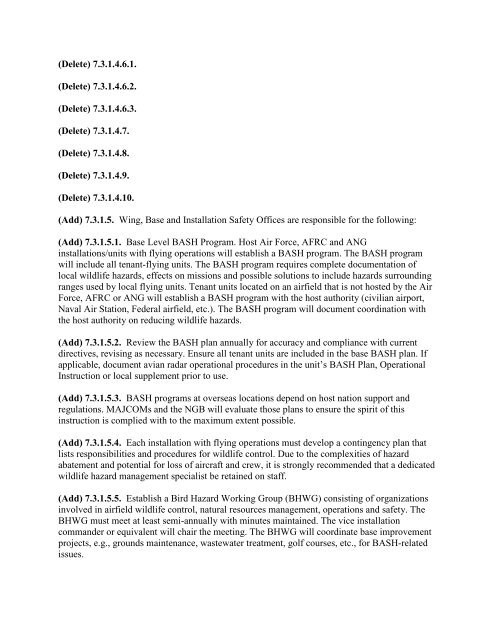MEMORANDUM FOR A1 - Air Force E-Publishing
MEMORANDUM FOR A1 - Air Force E-Publishing
MEMORANDUM FOR A1 - Air Force E-Publishing
You also want an ePaper? Increase the reach of your titles
YUMPU automatically turns print PDFs into web optimized ePapers that Google loves.
(Delete) 7.3.1.4.6.1.<br />
(Delete) 7.3.1.4.6.2.<br />
(Delete) 7.3.1.4.6.3.<br />
(Delete) 7.3.1.4.7.<br />
(Delete) 7.3.1.4.8.<br />
(Delete) 7.3.1.4.9.<br />
(Delete) 7.3.1.4.10.<br />
(Add) 7.3.1.5. Wing, Base and Installation Safety Offices are responsible for the following:<br />
(Add) 7.3.1.5.1. Base Level BASH Program. Host <strong>Air</strong> <strong>Force</strong>, AFRC and ANG<br />
installations/units with flying operations will establish a BASH program. The BASH program<br />
will include all tenant-flying units. The BASH program requires complete documentation of<br />
local wildlife hazards, effects on missions and possible solutions to include hazards surrounding<br />
ranges used by local flying units. Tenant units located on an airfield that is not hosted by the <strong>Air</strong><br />
<strong>Force</strong>, AFRC or ANG will establish a BASH program with the host authority (civilian airport,<br />
Naval <strong>Air</strong> Station, Federal airfield, etc.). The BASH program will document coordination with<br />
the host authority on reducing wildlife hazards.<br />
(Add) 7.3.1.5.2. Review the BASH plan annually for accuracy and compliance with current<br />
directives, revising as necessary. Ensure all tenant units are included in the base BASH plan. If<br />
applicable, document avian radar operational procedures in the unit’s BASH Plan, Operational<br />
Instruction or local supplement prior to use.<br />
(Add) 7.3.1.5.3. BASH programs at overseas locations depend on host nation support and<br />
regulations. MAJCOMs and the NGB will evaluate those plans to ensure the spirit of this<br />
instruction is complied with to the maximum extent possible.<br />
(Add) 7.3.1.5.4. Each installation with flying operations must develop a contingency plan that<br />
lists responsibilities and procedures for wildlife control. Due to the complexities of hazard<br />
abatement and potential for loss of aircraft and crew, it is strongly recommended that a dedicated<br />
wildlife hazard management specialist be retained on staff.<br />
(Add) 7.3.1.5.5. Establish a Bird Hazard Working Group (BHWG) consisting of organizations<br />
involved in airfield wildlife control, natural resources management, operations and safety. The<br />
BHWG must meet at least semi-annually with minutes maintained. The vice installation<br />
commander or equivalent will chair the meeting. The BHWG will coordinate base improvement<br />
projects, e.g., grounds maintenance, wastewater treatment, golf courses, etc., for BASH-related<br />
issues.
















